South Africa
Things to Read
Guide-book
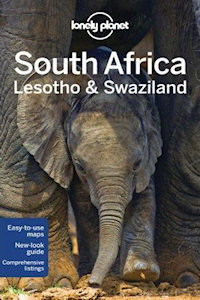
Lonely Planet
South Africa Lesotho and Swaziland
ISBN: 9781741798005
9th Edition, May 2012
Lonely Planet South Africa, Lesotho & Swaziland is your passport to all the most relevant and
up-to-date advice on what to see, what to skip, and what hidden discoveries await you.
Hike to the summit of Table Mountain, enjoy the diverse wildlife at Kruger National Park, or power down in a traditionally designed rondavel; all with your trusted travel companion.
Get to the heart of South Africa, Lesotho, and Swaziland and begin your journey now!
Hike to the summit of Table Mountain, enjoy the diverse wildlife at Kruger National Park, or power down in a traditionally designed rondavel; all with your trusted travel companion.
Get to the heart of South Africa, Lesotho, and Swaziland and begin your journey now!
- Full-colour maps and images throughout
- Highlights and itineraries show you the simplest way to tailor your trip to your own personal needs and interests
- Insider tips save you time and money and help you get around like a local, avoiding crowds and trouble spots
- Honest reviews for all budgets - including eating, sleeping, sight-seeing, going out, shopping, and hidden gems that most guidebooks miss
- Cultural insights give you a richer and more rewarding travel experience - including customs, history, art, literature, cinema, music, politics, landscapes, wildlife, and cuisine
- Useful features - including Travel with Children, Month-by-Month (annual festival calendar), and Activities & Adventures
Fieldguide
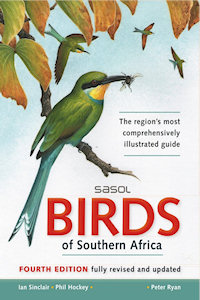
Ian Sinclair, Phil Hockey, Warwick Tarboton, Peter Ryan
SASOL Birds of Southern Africa
ISBN: 9781770079250
Oct 2011
First published in 1993, Sasol Birds of Southern Africa is one of the best-selling field guides on the
African continent.
This fourth edition has been rewritten and greatly improved, ensuring it remains the region’s most comprehensively illustrated and trusted field guide.
In this fourth edition: species accounts have been rewritten and now include group introductions; plates have been newly designed for ease of use and comparison; more than 380 new improved illustrations replace earlier ones; illustrations have simplified labels, pinpointing key differentiating features; distribution maps have been updated, showing the relative abundance of a species in the region, and also indicating resident or migrant status.
Other features include calendar bars that show species’ occurrence and breeding periods, a section on ‘how to use this book’, as well as sonograms depicting the calls of difficult-to-distinguish birds that have distinctive calls.
This fourth edition has been rewritten and greatly improved, ensuring it remains the region’s most comprehensively illustrated and trusted field guide.
In this fourth edition: species accounts have been rewritten and now include group introductions; plates have been newly designed for ease of use and comparison; more than 380 new improved illustrations replace earlier ones; illustrations have simplified labels, pinpointing key differentiating features; distribution maps have been updated, showing the relative abundance of a species in the region, and also indicating resident or migrant status.
Other features include calendar bars that show species’ occurrence and breeding periods, a section on ‘how to use this book’, as well as sonograms depicting the calls of difficult-to-distinguish birds that have distinctive calls.
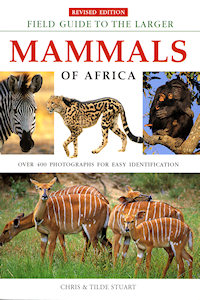
Chris & Tilde Stuart
Larger Mammals of Africa
ISBN: 978-1-77007-292-7
3rd edition 2006
In this updated and revised edition of field Guide to the Larger Mammals of Africa authors Chris
and Tilde Stuart concentrate on the more visible and easily distinguished larger mammals species, plus
some of the more frequently seen smaller mammals.
In all, over 400 colour photographs, combined with concise, pertinent information highlighting the diagnostic features of each species, provide a comprehensive source of data on each mammal. The latest information has been incorporated and the distribution maps have been revised to reflect the most up-to-date habitat and distribution patterns for each species.
A new feature is the inclusion of the mammals'skulls, grouped together at the back of the book. To aid the reader, colour coding and symbols indicating the habitat and activity period serve as a quick reference to the various mammal groups.
In all, over 400 colour photographs, combined with concise, pertinent information highlighting the diagnostic features of each species, provide a comprehensive source of data on each mammal. The latest information has been incorporated and the distribution maps have been revised to reflect the most up-to-date habitat and distribution patterns for each species.
A new feature is the inclusion of the mammals'skulls, grouped together at the back of the book. To aid the reader, colour coding and symbols indicating the habitat and activity period serve as a quick reference to the various mammal groups.
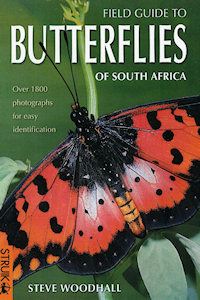
Steve Woodhall
Field Guide to Butterflies of South Africa
ISBN: 1868727246
Aug 2005
Field Guide to Butterflies of South Africa is designed for easy, rapid identification of all
butterflies likely to be seen in South Africa.
Following a worldwide trend to butterfly watching, readers are encouraged to observe behaviour rather than collect specimens. A detailed introductory section discusses butterfly biology, behaviour and anatomy, and butterfly families and subfamilies.
A comprehensive section on individual butterfly species supplies a wealth of information - scientific and English common names, information on flight periods and numbers of broods, behavioural traits and differentiation from similar species, as well as notes on size, geographical distribution and larval food sources.
Photographs are mostly of live specimens taken in the wild, and include under- and uppersides, and dimorphism where necessary.
Steve Woodhall (b 1957, Rochdale, UK) has been chasing butterflies with a net or camera most of his life.
In 1980 he achieved a life's ambition and emigrated to Africa, and now lives near Durban in South Africa. He's been photographing butterflies almost all that time, and when his old friend Bill Hansford-Steele (author of several books on Fly Fishing in Africa) suggested he should do a book, he decided to have a go!
Soon afterwards he made contact with Bill's publishers Struik Nature. After a lot of hard work and photography, in 2005 Field Guide to Butterflies of South Africa saw the light of day.
It was the first hand held comprehensive field guide to South African butterflies, with text opposite pictures.
Following a worldwide trend to butterfly watching, readers are encouraged to observe behaviour rather than collect specimens. A detailed introductory section discusses butterfly biology, behaviour and anatomy, and butterfly families and subfamilies.
A comprehensive section on individual butterfly species supplies a wealth of information - scientific and English common names, information on flight periods and numbers of broods, behavioural traits and differentiation from similar species, as well as notes on size, geographical distribution and larval food sources.
Photographs are mostly of live specimens taken in the wild, and include under- and uppersides, and dimorphism where necessary.
Steve Woodhall (b 1957, Rochdale, UK) has been chasing butterflies with a net or camera most of his life.
In 1980 he achieved a life's ambition and emigrated to Africa, and now lives near Durban in South Africa. He's been photographing butterflies almost all that time, and when his old friend Bill Hansford-Steele (author of several books on Fly Fishing in Africa) suggested he should do a book, he decided to have a go!
Soon afterwards he made contact with Bill's publishers Struik Nature. After a lot of hard work and photography, in 2005 Field Guide to Butterflies of South Africa saw the light of day.
It was the first hand held comprehensive field guide to South African butterflies, with text opposite pictures.
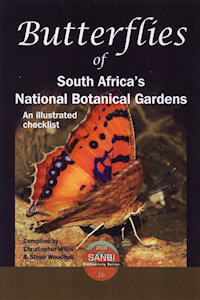
SANBI Biodiversity Series 16
Butterflies of South Africa's National Botanical Gardens
2010
Butterflies have formed one of the more visible, but not always noticed, components of the biodiversity
of South Africa's National Botanical Gardens (NBGs) since Kirstenbosch was established in 1913.
With the transition of the National Botanical Institute (NBI) to the South African National Biodiversity Institute (SANBI) in September 2004, the mandate of the organisation expanded from its main focus on plants to include all aspects of biological diversity.
So far 205 butterfly taxa have been recorded in the nine National Botanical Gardens combined. This represents 26% of South Africa's 801 known butterfly taxa.
Butterflies are probably the most popular order of insects among the general public and serve as important flagships for the public's perception of invertebrate conservation.
Additionally, many butterflies are threatened owing largely to habitat loss and modification.
Botanical gardens have an important local conservation value for butterflies and other insects.
With the transition of the National Botanical Institute (NBI) to the South African National Biodiversity Institute (SANBI) in September 2004, the mandate of the organisation expanded from its main focus on plants to include all aspects of biological diversity.
So far 205 butterfly taxa have been recorded in the nine National Botanical Gardens combined. This represents 26% of South Africa's 801 known butterfly taxa.
Butterflies are probably the most popular order of insects among the general public and serve as important flagships for the public's perception of invertebrate conservation.
Additionally, many butterflies are threatened owing largely to habitat loss and modification.
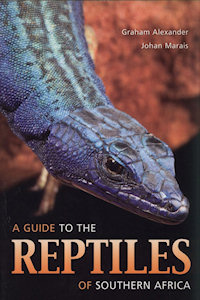
Graham Alexander and Johan Marais
A Guide to the Reptiles of Southern Africa
ISBN: 9781770073869
December 2007
Southern Africa is home to a remarkably diverse and rich reptile fauna.
A Guide to the Reptiles of Southern Africa introduces the 517 species currently described in the region, arranged into three main groups - snakes and lizards, crocodiles, and shelled reptiles.
Drawing on the latest scientific research, the authors start with a discussion of reptile identification, diversity, biology, distribution patterns, and where to find and observe them, as well as unravelling the facts and fallacies of snakebite.
Informative panels provide key information at a glance, with a distribution map and clear icons giving typical habitat and period of activity.
The full colour photographs throughout brings the subject matter vividly to life.
This book will appeal to all wildlife enthusiasts, both professional and amateur, and will prove to be a valuable guide in the field.
A Guide to the Reptiles of Southern Africa introduces the 517 species currently described in the region, arranged into three main groups - snakes and lizards, crocodiles, and shelled reptiles.
Drawing on the latest scientific research, the authors start with a discussion of reptile identification, diversity, biology, distribution patterns, and where to find and observe them, as well as unravelling the facts and fallacies of snakebite.
Informative panels provide key information at a glance, with a distribution map and clear icons giving typical habitat and period of activity.
The full colour photographs throughout brings the subject matter vividly to life.
This book will appeal to all wildlife enthusiasts, both professional and amateur, and will prove to be a valuable guide in the field.
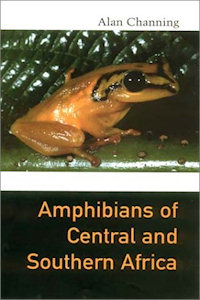
Alan Channing
Amphibians of Central and Southern Africa
ISBN: 0801438659
November 2001
Amphibians of Central and Southern Africa is the first comprehensive guide to the frogs, toads,
and caecilians of the ten sub-equatorial African countries—Angola, Botswana, Lesotho, Malawi, Mozambique,
Namibia, South Africa, Swaziland, Zambia, and Zimbabwe.
The result is at once a valuable reference tool, a field guide, and a source of ideas for future research.
A source of increasing interest in their own right, amphibians are also benchmark species for biodiversity, and are used as laboratory animals in many of the sciences. In the wild, amphibians, especially frogs, act as natural monitors of water quality and are invaluable in pest control.
Their skins secrete a wide range of pharmacologically active substances, such as antibiotics and painkillers. Yet frog populations are declining worldwide, mainly due to human destruction of their habitats.
Alan Channing synthesizes information published over the last century to provide the first natural history and a portrait of the amphibian fauna of this vast region.
Key features of Amphibians of Central and Southern Africa include
The result is at once a valuable reference tool, a field guide, and a source of ideas for future research.
A source of increasing interest in their own right, amphibians are also benchmark species for biodiversity, and are used as laboratory animals in many of the sciences. In the wild, amphibians, especially frogs, act as natural monitors of water quality and are invaluable in pest control.
Their skins secrete a wide range of pharmacologically active substances, such as antibiotics and painkillers. Yet frog populations are declining worldwide, mainly due to human destruction of their habitats.
Alan Channing synthesizes information published over the last century to provide the first natural history and a portrait of the amphibian fauna of this vast region.
Key features of Amphibians of Central and Southern Africa include
- detailed accounts for 205 species of frogs and toads (and 2 species of caecilian) accompanied by color illustrations, distribution maps, details of breeding and tadpole behavior, and call descriptionsmaps
- llustrations and tadpole identification keys for each genus
- special sections for some species with topics such as "skin toxins"
- an overview of fossil frogs, a discussion of humankind and frogs in Africa, and a bibliography of African frog biology
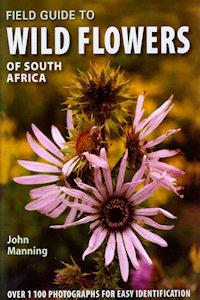
John Manning
Field Guide to Wild Flowers of South Africa
ISBN: 9781770077584
Aug 2009
South Africa, together with Lesotho and Swaziland, has a diverse landscape and equally varied flora,
which encompasses some 19,000 shrubs and herbs, a large proportion of which bear flowers of intricate and
often stunning beauty.
Field Guide to Wild Flowers of South Africa describes more than 1,100 of these, highlighting the most conspicuous species and those most likely to be encountered across the country.
A novel identification aid and easy-to-use keys guide users to the correct family and genus, while individual species descriptions, clear photographs, distribution maps and flowering seasons help pinpoint the plant.
With this guide, wildflower enthusiasts at all levels will now be able to identify plants accurately in any part of South Africa.
Dr JOHN MANNING is a Specialist Scientist at the South African National Botanical Institute in Cape Town.
He is a world specialist on the bulbs of Southern Africa but has wide-ranging interests in all aspects of South Africa's flora. He has published widely in scientific journals and is also committed to popularizing the indigenous flora.
He is the author or co-author of several popular wildflower guides.
Field Guide to Wild Flowers of South Africa describes more than 1,100 of these, highlighting the most conspicuous species and those most likely to be encountered across the country.
A novel identification aid and easy-to-use keys guide users to the correct family and genus, while individual species descriptions, clear photographs, distribution maps and flowering seasons help pinpoint the plant.
With this guide, wildflower enthusiasts at all levels will now be able to identify plants accurately in any part of South Africa.
Dr JOHN MANNING is a Specialist Scientist at the South African National Botanical Institute in Cape Town.
He is a world specialist on the bulbs of Southern Africa but has wide-ranging interests in all aspects of South Africa's flora. He has published widely in scientific journals and is also committed to popularizing the indigenous flora.
He is the author or co-author of several popular wildflower guides.